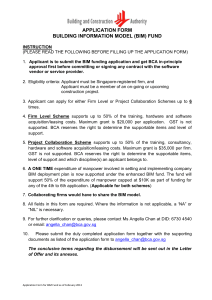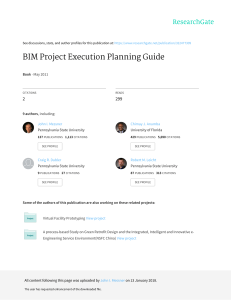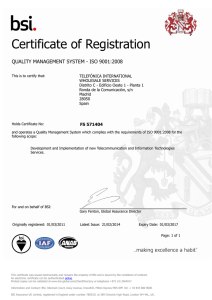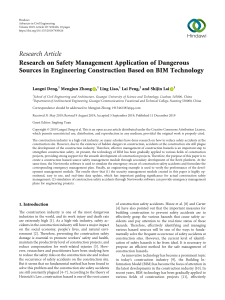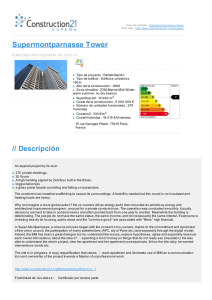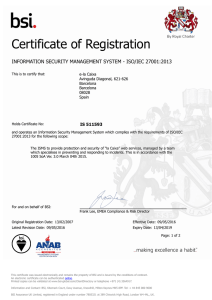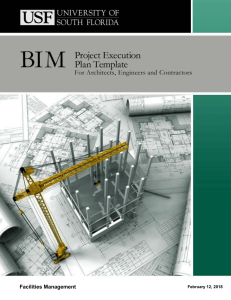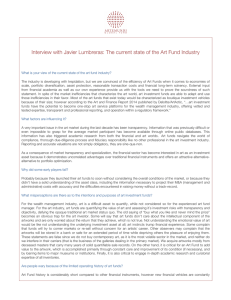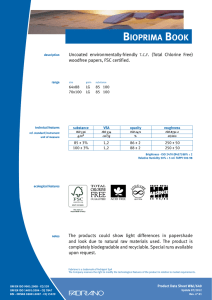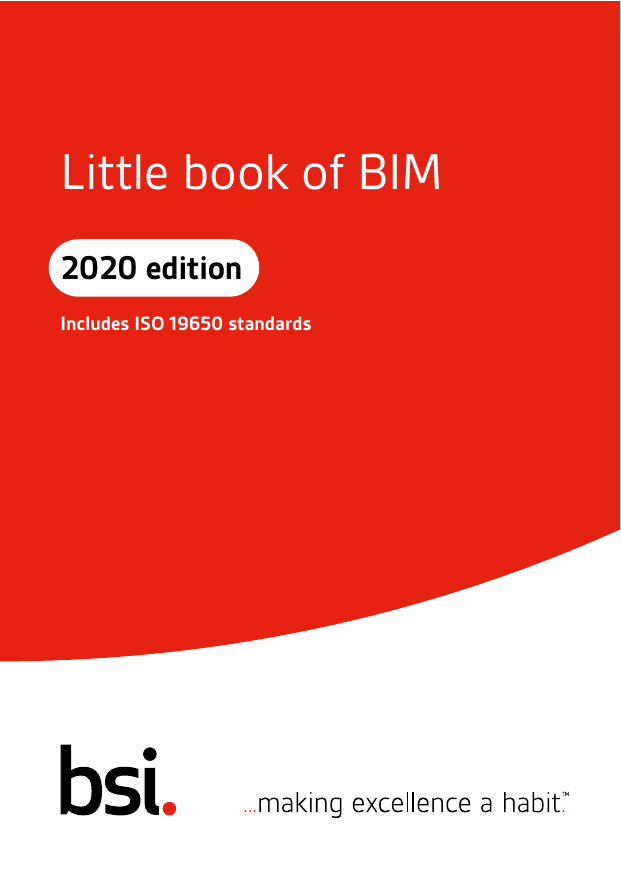
Little book of BIM 2020 edition Includes ISO 19650 standards Welcome to the BSI little book of BIM This handy guide is your quick reference to some of the key terms which are commonly used in describing BIM and its related processes, as well as your link to the key standards. If you or an organization you work with are using BIM, these terms will be familiar. This guide can be used by organizations across the supply chain. The global adoption of BIM continues to accelerate to deliver a sustainable, resilient built environment. Since the publication of the international standard ISO 19650, it is vital you understand the principles of information management. 1 Contents BIM definition 3 Core BIM standards 4 BIM guiding principles 7 Terms and abbreviations 10 Global BIM adoption 15 BSI BIM journey 16 Standards for your BIM journey 17 Your learning journey with BSI 18 BSI certification solutions 27 Why BSI? 32 BSI BIM enquiries 33 2 BIM definition Building Information Modelling (BIM) is a collaborative way of working underpinned by digital technologies. It uses a shared digital representation of an asset to facilitate design, construction and operation processes to form a reliable basis for decisions. Greater efficiencies can be realized due to significant pre-planning during the design and construction phases, providing comprehensive information at handover stage. 3 Core BIM standards BS EN ISO 19650-1:2018 – Organization and digitization of information about buildings and civil engineering works, including building information modelling (BIM) – Information management using building information modelling. Concepts and principles. BS EN ISO 19650-2:2018 – Organization and digitization of information about buildings and civil engineering works, including building information modelling (BIM) Information standard. Information production methods and procedures. BS EN ISO 19650-3:2020 – Organization and digitization of information about buildings and civil engineering works, including building information modelling (BIM). The asset information standard and asset production methods and procedures. BS EN ISO 19650-5:2020 – Organization and digitization of information about buildings and civil engineering works, including building information modelling (BIM). Information management using building information modelling. Includes the security strategy, security management plan, and the security breach/incident management plan. 4 BS 1192-4:2014 – Collaborative production of information. Fulfilling employer’s information exchange requirements using COBie. Code of practice. PAS 1192-6:2018 – Specification for collaborative sharing and use of structured Health and Safety information using BIM. BS 8536-1:2015 – Briefing for design and construction. Code of practice for facilities management (Buildings infrastructure). BS 8536-2:2016 – Briefing for design and construction. Code of practice for asset management (Linear and geographical infrastructure). BS 8541-1:2012 – Library objects for architecture, engineering and construction. Identification and classification. Code of practice. BS 8541-3:2012 – Library objects for architecture, engineering and construction. Shape and measurement. Code of practice. BS 8541-4:2012 – Library objects for architecture, engineering and construction. Attributes for specification and assessment. Code of practice. 5 To discover the BIM standards, visit: ukbimframework.org/standards-guidance To discover library objects standards, visit: BS 8541 standards Additional international standards referenced in BSI BIM certification schemes BS ISO 44001:2017 – Collaborative business relationship management systems. Requirements and framework. BS EN ISO 9001:2015 – Quality management systems. Requirements. BS EN ISO 55001:2014 – Asset management. Management systems. Requirements. BS EN ISO/IEC/27001:2017 – Information technology. Security techniques. Information security management systems. Requirements. BS ISO 10004:2018 – Quality management. Customer satisfaction. Guidelines for monitoring and measuring. 6 BIM guiding principles BIM has formalized principles relating to assets should be designed, built and operated in order to best realize an asset's value and potential offered by this new way of working. People, processes and technology BIM is not just about technology; it's a new way of designing, building and operating assets enabled by the use of technology. Equally, if not more fundamental than technology is the set of processes that should be followed (outlined within the ISO 19650 and BS/PAS 1192 series of standards) as well as the change in working practices at an operations level. This is best exemplified by the need for a collaborative approach across the supply chain. Collaborative engagement One of the key success indicators of a project using BIM is the degree to which the supply chain has worked in collaboration to meet the project/asset needs. This means working openly as well as sharing information and experience with supply chain members in a way that encourages collective problem solving and coordination. 7 Start with the end in mind A key problem that is addressed by using BIM is the issue of rushed decisions being made with insufficient and/or incorrect information. Starting with the end in mind, these decisions are pushed “up-stream” so that they are better informed and do not present themselves unexpectedly. Examples of this include; completing all principle design work and coordination before the commencement of construction, and ensuring that design decisions are being made across the entire delivery phase with respect to the operational performance and utilization of the asset (BS 8536). Digital asset It's becoming increasingly recognized that monetary value is not solely attributed to the physical asset, but also attributed to the representation of that asset, in other words, the collective sum of all data/information describing the physical asset. Knowing that this digital asset accurately represents the physical asset; design, construction and operating decisions can be optimized. 8 Holistic approach to security Once it has been identified what needs to be protected and the threats and consequences associated to this, (in order to ensure the security of a sensitive asset and sensitive information) a holistic approach should be adopted covering people, process, technological security and physical security. 9 Terms and abbreviations There are many terms which form part of the BIM language. Whilst not exhaustive, here are some of the common ones to look out for. CDE Common Data Environment A workflow to control the single source of information for any given project or asset. Used to manage the collection and dissemination of all relevant approved project/asset information. Used in combination with a digital storage solution, information is shared collaboratively in a logical and accessible way to help all key parties readily gain access to information, using consistent naming conventions, avoiding duplication and retaining ownership. Status code This is a meta-data field within the CDE workflow which is used to describe the suitability of the information to which the status code is assigned. The status code identifies the permitted use of the information and can be used to help facilitate specific workflows. 10 OIR Organization Information Requirements This specifies what information is required to achieve an organization’s strategic objectives in relation to business operation, asset management, portfolio planning etc. The OIR may be developed from an ISO 55001 asset management system. AIR Asset Information Requirements This defines the information that is required, and the managerial and technical aspects of producing this information, for the operation of an asset. EIR Exchange Information Requirements This specifies the information that is required related to a specific appointment (contract). It includes responsibility, timescales, format and level of information need of the project information; consisting of the relevant information requirements from the OIRs, AIRs and PIRs. PIR Project’s Information Requirements This specifies the information that is required related to a specific project; consisting of the relevant information requirements from the OIRs and AIRs. 11 Level of information need This is a methodology to specify the granularity of information to support a given purpose. This should be defined as the minimum granularity to avoid overproduction of information leading to waste. Project’s Information standard This establishes requirements on the exchange of information, the structuring and classification of information, assignment of level of information need and use of information in the operational phase of the asset. Project’s Information Production Methods and Procedures This establishes the methods and procedures required to be used when generating, reviewing, distributing or delivering information. BEP BIM Execution Plan This specifies the delivery plan which will be undertaken by the delivery team as a response to the received tender documentation. It includes, amongst other things, who is responsible for providing information, as well as who will be undertaking which responsibilities within the delivery team. 12 Delivery team’s Mobilization Plan This details the approach, timescales and responsibilities for the delivery team to be implemented during mobilization. This includes testing information exchanges between task teams and testing the proposed information production methods and procedures. MIDP Master Information Delivery Plan Developed from the BIM Execution plan, this is the primary plan for when information is going to be prepared, by whom and when. It also sets out the format and the timescales. Each information deliverable will be aligned to a defined project delivery milestone. TIDP Task Information Delivery Plan This is a plan, developed by each task team, which is incorporated into the Master Information Delivery Plan based on the agreed responsibilities outlined within the BIM Execution Plan. Delivery Team’s Risk Register This details the delivery team’s risk associated with the timely delivery of information deliverables inaccordance with the EIR. Considered risks include (amongst others), meeting the information delivery milestones and adoption of the project’s information standard. 13 PIM Project Information Model This is the aggregation of information developed during the design/construction phase of the project. Information that forms the PIM is created by the project team controlled by the CDE workflow. As the project develops so too will the PIM, which will increase in both size and accuracy; starting as a design intent progressing to a record of construction once complete. COBie Construction Operation Building Information Exchange This is a structured method of exchanging information about maintainable assets. COBie, often delivered as a spreadsheet, has a pre-defined structure that is used to share this information in both a human-readable and machine-interpretable manner. AIM Asset Information Model This is the aggregation of information needed to support the management and operation of the asset (infrastructure or building). The AIM is typically formed or updated using a subset of the PIM at the handover stage of a project. The AIM will continually be updated and developed as information is provided following works that affect the asset. 14 Global BIM adoption Governments around the world are accelerating the adoption of BIM, or are starting to introduce different requirements to embed the adoption of BIM, by mandating or setting conditions of contract for public works projects, infrastructure projects or projects defined by scale. The publication of international BIM standards supports this adoption. These standards define the minimum requirements and give further recommendations on applying best practice. Use of the internationally recognized BIM standards will help remove barriers to collaborative working and competitive tendering across borders. The international BIM standards offer the potential to act as a passport for organizations that embed them to gain access to international markets. With the publication of ISO 19650, parts 1 and 2, BIM now has an internally agreed definition. 'BIM according to ISO 19650' defines the minimum requirements and gives further recommendations to to applying best practice to BIM. 15 BSI BIM journey BSI BIM journey Qualifications Certification and beyond Achieve a BSI qualification in BIM Project/Asset information to validate your learning through a combination of learning and assessment. You can also opt to become a Certified Professional. Once certified, annual surveillance visits will ensure adherance to the latest standards. Certification suite Specific training Understanding the requirements and practice of ISO 19650-2, PAS 1192-3, BS 1192-4, ISO 19650-5, PAS 1192-6. BIM Design and Construction Introductory training Collaborative BIM: Senior Management Briefing* or Senior Management Workshop* BIM Asset Management BIM Fundamentals – Putting BIM into practice. BIM Security BIM Objects BIM Standards Buy and read the BIM standards Standards 16 Training suite Gap assessment Optional assessment to identify any gaps in documentation required by the standard. Standards for your BIM journey British Standards Online (BSOL), our online standard management tool, gives you access to BIM standards and as well as over 9,000 standards related to the built environment, including construction and civil engineeringspecific standards. Our standards are designed to help you establish good practice, build resilience, embrace new technologies and be fit for the future. Access the standards you need in one place – BS, EN, ISO, PAS, IEC and ASTM standards. With BSOL, anyone in your organization that needs access to multiple standards can view and download them. Subscribe to Pre-built modules or Build a personalized standards collection. With BSOL you get: • One access for all your standards • Reduced risk within your organization • Instilled trust with your clients We have been serving construction and built environment since 1901, helping embed excellence across the globe to improve business performance and resilience. bsigroup.com/en-GB/built-environment-bsol-uk 17 Your learning journey with BSI Our range of courses is designed to meet the needs of your entire business, from operational teams to senior leaders. Our training programmes support the learning journey of people at every stage – from understanding the requirements of a standard to leading a team of auditors, as well as tools and techniques to improve the performance of your business. Qualifications Having a qualification is becoming increasingly important as clients, employers and supply chains look for confidence and reassurance that skills and competence have been tested and validated. For a BSI Qualification, you’ll take a series of training courses and examinations, and to become a Certified Professional, we ask you to submit evidence of practical application, as well as three years’ experience. Visit: bsigroup.com/training 18 BIM Fundamentals – putting BIM into practice This course is designed to raise your awareness and introduce you to the basic principles of BIM. It will explain how BIM principles help to reduce waste in construction and asset management. We’ll provide you with an overview of the standards that define BIM implementation and the fundamental processes of a Common Data Environment (CDE). This course is ideal if you’re adopting BIM practices into your organization or helping your clients or supply chains to adopt it. It will be particularly useful for construction and asset management professionals including project managers, asset managers, designers, constructors, manufacturers, maintenance contractors, and information managers. Duration: two days 19 Collaborative BIM: Senior Management Briefing This course is designed to give you an understanding of how BIM can benefit your organization, your clients and supply chain. It will also cover the impact of digitization, lean and collaborative approaches on the delivery and use of assets, highlighting the importance of placing BIM within project delivery and asset management processes. This course is ideal if you’re involved in communicating the benefits of BIM within your organization. It’s particularly useful for chief officers, directors and senior partners with project and portfolio responsibilities. Duration: half a day 20 Collaborative BIM: Senior Management Workshop This course will help you understand the benefits of digitization, lean and collaborative approaches in the delivery and use of built assets. It will also provide an introduction to ISO 19650, for building information modelling (BIM), and collaborative working. You’ll be able to understand the methods for setting clear purposes and priorities as part of a BIM strategy, and gain an appreciation of UK PAS 1192-3 and BS 8536 for infrastructure and buildings. This course is ideal if you’re a senior manager tasked with introducing BIM to your organization, or if you’re involved in BIM processes for project delivery and asset management. Duration: one day 21 Building Information Modelling (BIM): Digital Built Britain, IoT and SmartCities Attention is now turning to the nature and implications of BIM and beyond; including social integration, Smart Cities (Communities), Geographical Information Systems (GIS), Internet of Things (IoT) and Smart Contracts. This course will help you engage with the implications of the wider scope of built environment data and information management. You’ll start to understand how you can exploit the opportunities that this might provide. Please note that this course has been developed with a UK focus but it may still be of interest to you. This course is ideal for clients, asset owners, designers, construction, commissioning and facility managers who may need to anticipate the latest developments in the creation and management of the built environment. Duration: one day 22 Specific BIM standards training courses BIM ISO 19650-2: Project Delivery This course will help you understand the information management processes that are needed for a design and construction project to be delivered using BIM according to ISO 19650-2: Project Delivery Phase. It follows on from the BIM Fundamentals course, where information management concepts and principles are introduced. This course is ideal for project clients, designers (architects, structural and civil engineers, services engineers, etc.), main contractors and sub-contractors, manufacturers of complex products and components. Asset and facilities managers will also find it helpful to find out how operational information is specified and delivered during a construction project. Duration: one day 23 BIM PAS 1192-3: Asset Management This course aims to give you a detailed understanding of the PAS 1192-3 standard. It explains how information requirements are developed for different life-cycle events, and the different roles involved in BIM asset information management. This course is ideal if you’re involved in communicating the benefits of BIM within your organization. It’s particularly useful for: • Asset or facilities managers working on behalf of asset owners or operators • Asset contractors or in-house teams delivering maintenance, repairs, minor refurbishment works and condition surveys • Project information managers (client side or supply side) may also find it helpful to understand how operational information gets specified as part of project Exchange Information Requirements (EIR). Duration: one day 24 BIM BS 1192-4: Handover Information Exchange This course will help you obtain the benefits of COBie as the digital information exchange between design and supply chain, and the client or operator. It will give you an introduction to BS 1192 and collaborative working. It also highlights the importance of clear Asset Information Requirements and a checkable digital Plan of Work. This course is ideal if you’re involved in communicating the benefits of BIM within your organization. It is also particularly useful for design and construction managers charged with delivering COBie, typically within a BIM project. Duration: one day 25 BIM 19650-5: Security and BIM This course will help you address security implications for built assets from information modelling. It will explain how the components of PAS 1192-5, securitymindedness, relate to each other. This course is ideal for clients, designers, facilities, construction and commissioning managers who may need to implement security policies in relation to the built environment. Duration: one day BIM PAS 19650-6: Health and Safety This course will help you understand the benefits of structured health and safety information and its digital information exchange amongst design and supply chain, and the client or operator. The importance of clear Asset Information Requirements (AIR) and a checkable digital Plan of Work will be emphasized. This course is ideal for clients, designers, facilities, construction and commissioning managers charged with delivering health and safety within a collaborative or BIM project. Duration: one day 26 BSI certification solutions BIM Verification for Design and Construction Based on ISO 19650 (Parts 1 and 2), this has been developed for any organization involved in using BIM. It will help you demonstrate your BIM capability through independent and impartial third-party verification. E PL M A X E BSI Kitemark™ for Design and Construction Suitable for any organization within a project team, the BSI Kitemark provides a robust measurement of a company’s delivery of BIM projects, certifying businesses for their diligence in design and construction, supply chain management and delivery of customer service excellence. As with other BSI Kitemarks, organizations holding the BSI Kitemark will be routinely assessed, providing clients with complete confidence in their delivery to industry standards. E E BIM Design and Construction PL M A X 27 “The BSI Kitemark is a respected brand. Applied to our services it will reinforce client confidence and prove greater quality in the delivery of BIM projects.” David Throssell, Head of Digital Construction, Skanska UK The BSI Kitemark for Design and Construction builds on BIM Verification for Design and Construction. It involves sampling of past, on-going and completed projects and assessment of customer satisfaction (through ISO 10004 Customer Satisfaction Guidelines for monitoring and measuring). It also uses additional assessment parameters through BS ISO 44001 Collaborative Business Relationships and builds on specific requirements from ISO 9001, Quality Management. BSI Kitemark for BIM Asset Management LE BIM Asset Management MP A X E 28 The BSI Kitemark for BIM Asset Management provides assurance that asset and facilities managers have integrated BIM into their asset management processes and confirms that asset information is accurate and up-to-date. We assess evidence of controlled documented procedures for all processes against the assessment standard PAS 1192-3, plus the delivery of assets to appointment requirements, measurement and monitoring of customer satisfaction, effective management of the supply chain and Quality Management (ISO 9001). “We are able to apply consistent standards and processes across the group for managing data and information over the lifecycle of assets. It helps build up the capability of our colleagues which will improve the quality of delivery and make the process efficient. The BSI Kitemark will ultimately improve the way we manage assets for our clients and ultimately for the society.” Navil Shetty, Director, Fellow and Technical Chair for Asset Management, Atkins Ltd 29 BSI Kitemark for BIM Security EXA PLE BIM Security M The BSI Kitemark for BIM security builds on the above two BIM Kitemarks and focuses on the assessment of how an organization is embedding security principles in alignment with PAS 1192-5 Specification for securityminded approach to building information modelling. This assessment will look into how you approach security with respect to physical systems, technological systems, personnel awareness/adoption of security, and organizational security processes. With security becoming an ever-more important factor for business continuity, ensuring that your organization is adopting an appropriate and proportionate security minded approach is vital. A BSI Kitemark can help you mitigate security risks. BSI Kitemark for BIM Objects The BSI Kitemark for BIM Objects is the benchmark in best practice for the production of digital products used in BIM models. Designed to prove EXA 30 E MPL BIM Objects manufacturers have embedded BIM within their product manufacturing processes, it covers the full range of construction products for structural, architectural and mechanical, electrical and plumbing. The Kitemark certification process ensures that your BIM Objects are a true likeness of your physical products, to give your customers complete confidence during design, construction and asset management. The assessment standard is BS 8541 – Library objects for architecture, engineering and construction: Part 1 – Identification and classification Part 3 – Shape and measurement Part 4 – Attributes for specification and assessment We’ve also developed an additional set of requirements for the BSI Kitemark that build on these standards and are based on industry feedback to help ensure your BIM content is of the highest quality. “The BSI Kitemark for BIM Objects demonstrates that Legrand has a robust set of processes in place for the production and management of BIM objects which is important as we continue on our digital journey” Matt Crunden, Training and BIM Manager, Legrand Electric 31 Why BSI? 193 countries 84,000 clients 3 regional hubs Advancing a safer, digitally enabled and sustainable built environment. Over one hundred years ago, our first standard reduced the number of tram track gauges from 75 down to 5. Today we now offer over 63,000 standards and we originated the world’s 3 most widely adopted standards: quality management, environmental management and occupational health and safety. We also help organizations all over the world implement this collective best practice, training 212,000 delegates and delivering 232,000 audit days over the last 12 months. BSI shaped the development of the BIM standards, and we continue to train and audit organizations throughout the supply chain from clients, principle contractors, sub contractors to manufacturers around the globe. 32 BSI BIM Contacto BSI Iberia Saber más Llame: +34 91 400 86 20 Visite: bsigroup.com/bim Email: info.esp@bsigroup.com Solicitudes formación BIM +34 91 080 07 85 33 The trademarks in this material (for example the BSI logo or the word “KITEMARK”) are registered and unregistered trademarks owned by The British Standards Institution in UK and certain other countries throughout the world. bsigroup.com Copyright © 2020, The British Standards Institution. All rights reserved. BSI/UK/1839/PC/0920/EN/BLD
